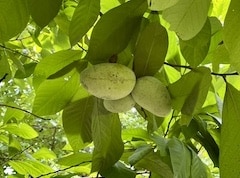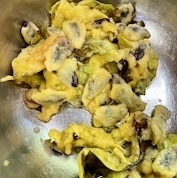 It’s been called America’s secret fruit, forgotten fruit and for many, an unknown fruit. But for some of us, it’s a backyard fruit. When your husband forgets to transplant a seedling to the farm until it becomes a small tree, finding the native fall fruit no longer becomes difficult. Despite its relatively unfamiliarity, the pawpaw has quite the historical background. In 1919, the pawpaw was predicted to be the fruit of the future, exceeding expectations for the blueberry and cranberry. While the predictions of the 20th century did not come true, the pawpaw, with its tropical-like taste and potential medical properties, raises curiosity about its future; a curiosity that comes with Kentucky ties.
It’s been called America’s secret fruit, forgotten fruit and for many, an unknown fruit. But for some of us, it’s a backyard fruit. When your husband forgets to transplant a seedling to the farm until it becomes a small tree, finding the native fall fruit no longer becomes difficult. Despite its relatively unfamiliarity, the pawpaw has quite the historical background. In 1919, the pawpaw was predicted to be the fruit of the future, exceeding expectations for the blueberry and cranberry. While the predictions of the 20th century did not come true, the pawpaw, with its tropical-like taste and potential medical properties, raises curiosity about its future; a curiosity that comes with Kentucky ties.
The History
The pawpaw is the largest edible fruit native to the United States. Historical data indicates that Native Americans living in the Mississippi River Valley relied on the pawpaw tree for its fruit to eat and its bark as cording to make fishing lines and repair baskets. Early American settlers across the southeastern part of the country valued the fruit as it was the only accessible fresh fruit.
Despite the clearing of the trees for farmland, the native trees, consisting of 27 varieties, have continued to thrive for centuries, mainly in the southeast but extending as far north as Michigan and as far west to Oklahoma, with a presence in about 26 states.
The Benefits
The uniqueness of the pawpaw is its green oblong shape and its flavor — a blend of banana and mango with a hint of pineapple or even papaya, depending on the variety. Its custard-like texture reflects its connection to the tropical custard apple family and explains the commonly used names of “American custard apple,” “poor man’s banana” or “Kentucky banana.”
 Like its name, the pawpaw has a similar nutritional profile to the banana. The fiber and calories are about the same and it is a good source of potassium, vitamin C, magnesium, iron, copper and manganese with significant amounts of riboflavin, niacin, calcium, phosphorus and zinc.
Like its name, the pawpaw has a similar nutritional profile to the banana. The fiber and calories are about the same and it is a good source of potassium, vitamin C, magnesium, iron, copper and manganese with significant amounts of riboflavin, niacin, calcium, phosphorus and zinc.
Beyond the nutrients, the pawpaw contains a type of phytochemical, known as acetogenin, in its twigs, bark and leaves that may have potential cancer fighting benefits.1 However, current studies are not sufficient to validate its merit. Likewise, the pawpaw contains high amounts of a chemical called annonacin. This can be toxic to nerve cells and can affect brain function if consumed in high quantities. It is recommended that pregnant women avoid pawpaws.
In addition to the health aspects of the fruit, pawpaw trees produce natural compounds that have potential commercial uses, including pesticides, topical medicinal and dietary supplements. Over the years, research has found that the extracts from the tree’s twigs and leaves have specific insecticidal properties and are used in products to treat head lice, ticks and fleas.2
The Limitations

And once the fruit is ripe, it’s RIPE! And it becomes a race with nature, especially the squirrels, to see who gets them first! Hence why you find a limited amount of the fruit and usually only at farmer’s markets in late August to early October. Once picked, pawpaws need to be eaten within 3 days or can be refrigerated up to 5 days.

Due to the fruit’s short shelf life, low fruit yields, and challenges in harvesting, processing and shipping, the availability of pawpaws is not common on a larger scale. Hence the need for research and here we find the Kentucky connection.
The Kentucky Connection
The only full-time pawpaw research program in the world resides in Frankfort, Kentucky, at Kentucky State University (KSU) through its Land Grant Program. The research efforts there are focused on developing the pawpaw as a fruit crop for small farmers or as edible landscape trees for nursery stock. Research is focused on improving the breeding methods and most importantly, understanding the fruit ripening and storage techniques to allow for market expansion. KSU also serves as the USDA National Clonal Germplasm Repository or gene bank, for the Asimina species (Pawpaw).4 This summer I had the opportunity to visit the KSU farm where over 2,000 trees from 17 states are planted. Quite an interesting pawpaw orchard.
Pickin’ Up a Pawpaw Someday?
What the future holds for widespread distribution of pawpaws depends on unlocking its limitations. For now, look for whole pawpaws or pulp at southeastern-based farmers’ markets in early fall, attend the annual Albany, Ohio, Pawpaw Festival or purchase frozen pulp from an online vendor. And if you’re in Kentucky, you may just find some pawpaw treats along the way.
Research holds the key to the pawpaw’s future; a future that hopefully can extend beyond just “pickin’ up pawpaws” and putting “‘em in your pocket.”5
References
1. “Health Benefits of Pawpaw Fruit,” by Shishira Sreenivas, Web MD, October 05, 2022.
2. PAWPAW, U.S. Department of Agriculture Fact Sheet, Revised June 2021.
3. Pawpaw Recipes and Uses Publications, Kentucky State University.
4. “Evaluation of Genetic Variation Among Native Pawpaw Patches at the Environmental Education Center at Kentucky State University,” Kentucky State University.
5. “Way down yonder in the paw paw patch,” a traditional folk song.
